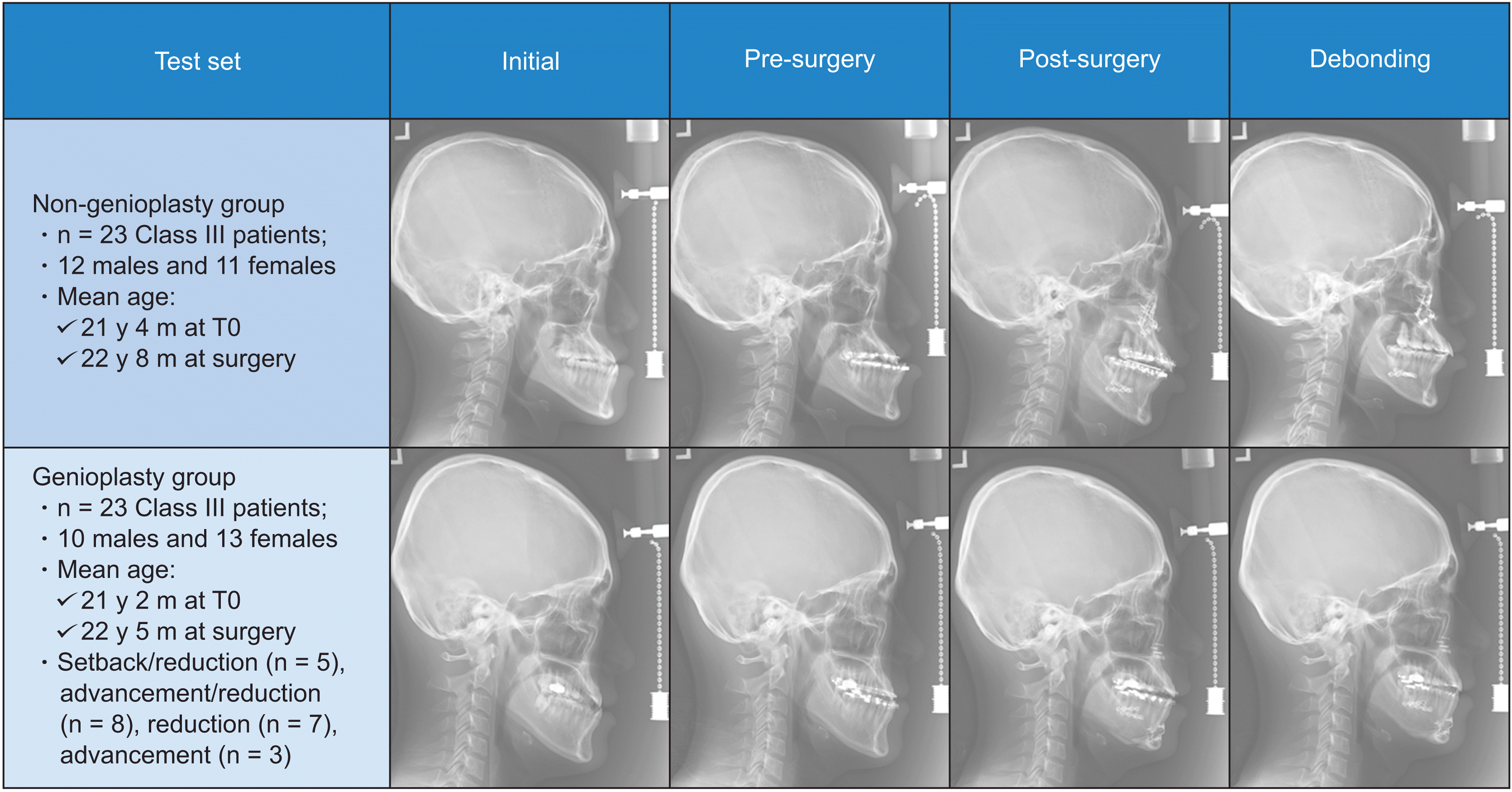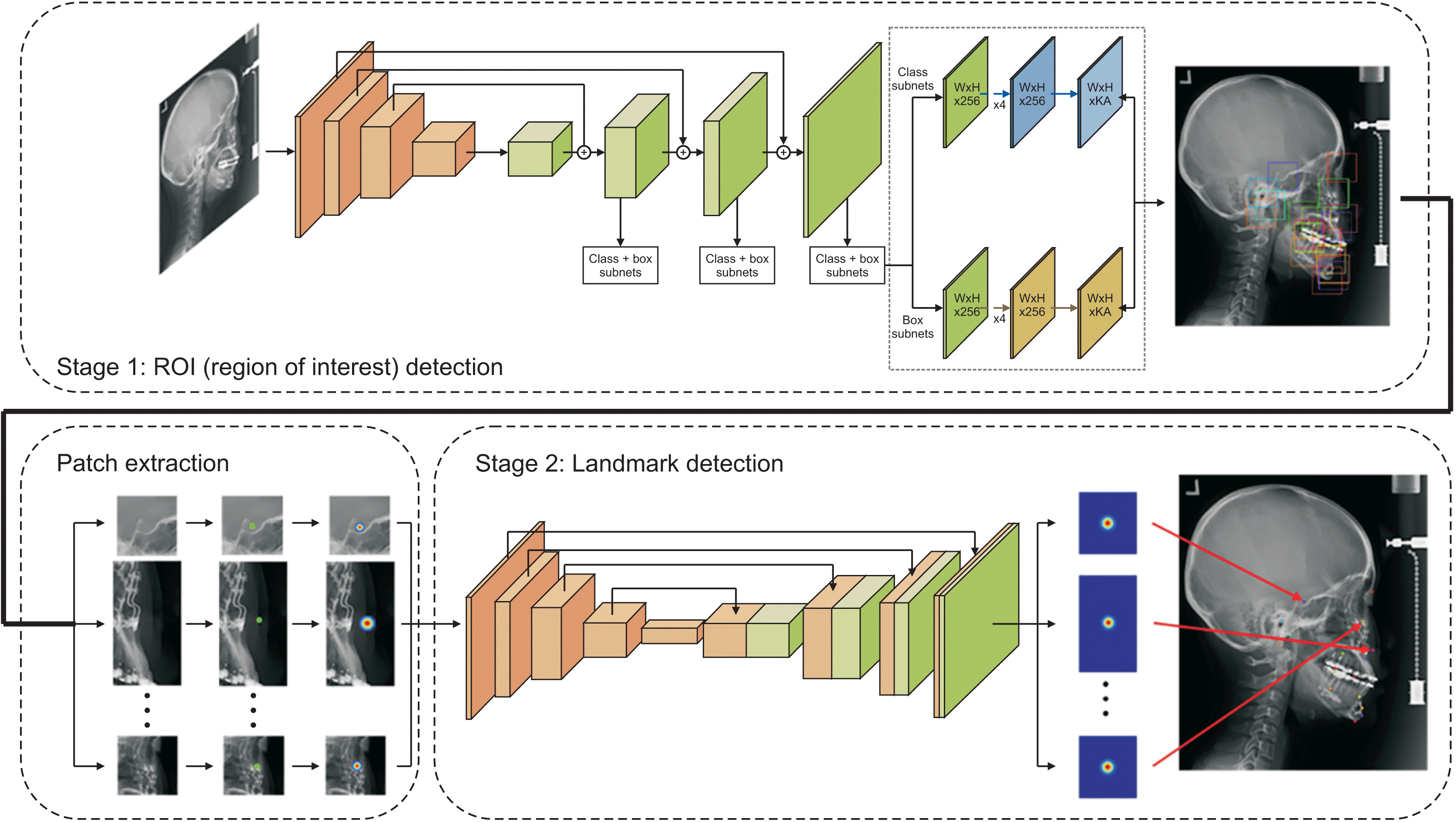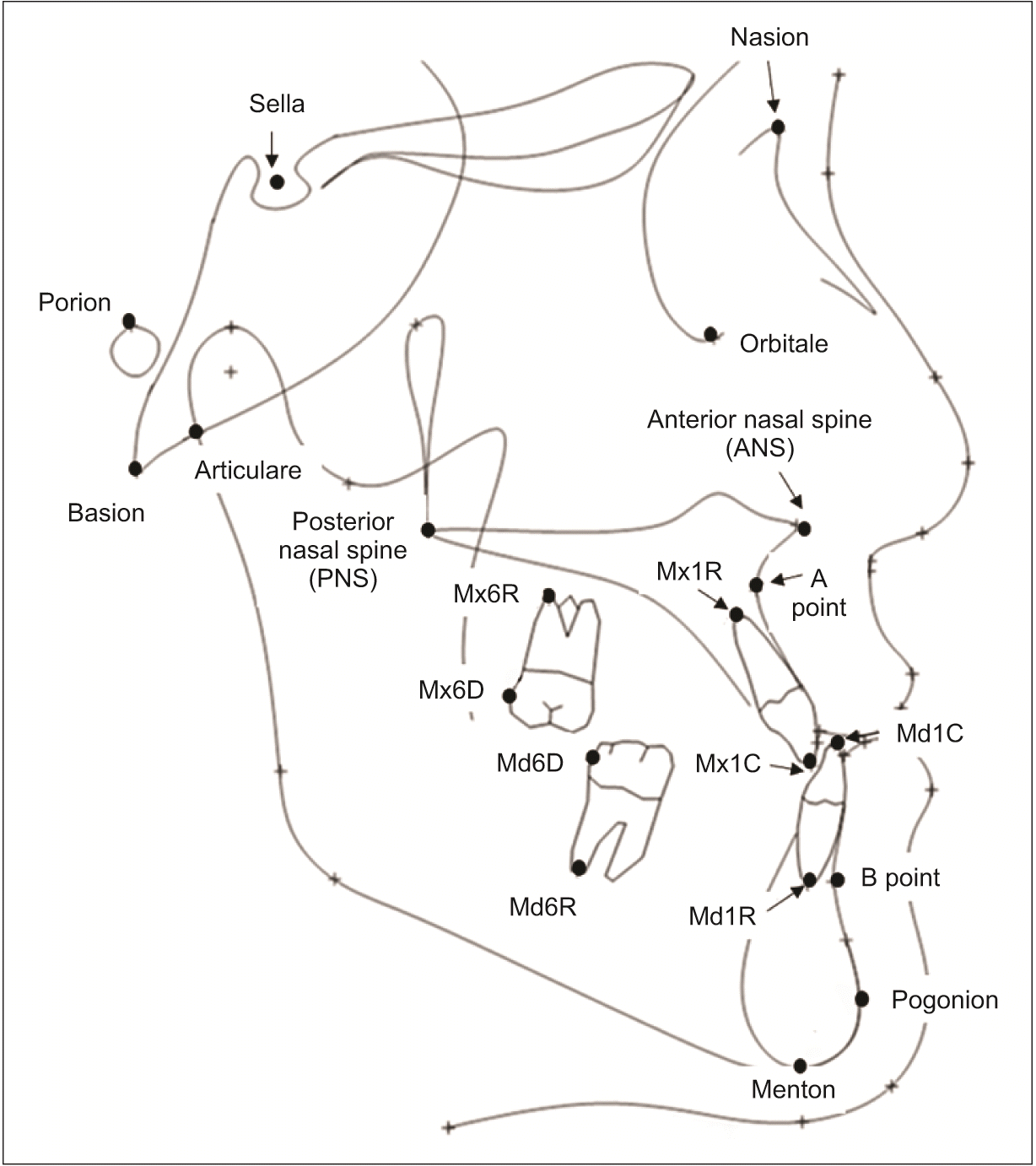INTRODUCTION
Owing to the high prevalence of Class III malocclusion and negative social recognition of the prognathic appearance,
1,2 Korea has become one of the countries that performs two-jaw orthognathic surgery (TJ-OGS) extensively in patients with skeletal Class III malocclusion. To obtain a successful treatment outcome, the following four steps should be performed precisely: (1) diagnosis and gross treatment planning for pre-surgical orthodontic treatment and orthognathic surgery using initial cephalograms, (2) planning for the direction and amount of surgical movement using pre-surgical cephalograms, (3) assessment of surgical outcome and planning for post-surgical orthodontic treatment using post-surgical cephalograms, and (4) comprehensive assessment of orthodontic treatment and orthognathic surgery using debonding cephalograms.
3,4 Furthermore, superimposition of serial cephalograms taken at different time-points is also important to assess the outcomes of pre- and post-surgical orthodontic treatment and orthognathic surgery. Accurate detection of cephalometric landmarks is mandatory to perform these procedures.
An artificial intelligence (AI) algorithm including convolutional neural network (CNN) can help clinicians detect cephalometric landmarks with an accuracy that is close to that of human experts.
5-12 Previous AI studies have regarded the accuracy within a range of 2 mm as a clinically acceptable performance in landmark identification.
8,12-15 However, it appears to be a lenient standard for appropriate clinical use. Therefore, use of stricter criteria (i.e., range within at least 1.5 mm) is necessary in determining the accuracy of landmark identification for clinical relevance.
In addition, most AI studies on the accuracy of automated landmark identification
8,13-15 have trained and tested their models using initial lateral cephalograms only, which do not have orthodontic brackets (OB), surgical plates and screws (S-PS), fixed retainer (FR), and bone remodeling changes. To the best of our knowledge, no study has compared the accuracy of automated landmark identification in serial cephalograms at the four time-points covering from the initial, pre-surgery, post-surgery, to debonding stages in orthognathic surgery cases. Therefore, the purpose of the study was to investigate the pattern of accuracy change in AI-assisted landmark identification in serial lateral cephalograms of Class III patients who underwent pre- and post-surgical orthodontic treatment and TJ-OGS using a cascade CNN algorithm and strict criteria for determining the degree of accuracy.
MATERIALS AND METHODS
Data set
A total of 3,188 lateral cephalograms of 797 patients with Class III malocclusion were used for the training and validation sets and the test set for automated landmark identification using the CNN model. The inclusion criteria were as follows: (1) Class III patient who underwent pre- and post-surgical orthodontic treatment and TJ-OGS with/without genioplasty and (2) Class III patient whose serial lateral cephalograms were available. The exclusion criterion was Class III patient who had craniofacial deformities.
The training and validation sets for automated landmark identification by the CNN model included 3,004 lateral cephalograms of 751 Class III patients from 10 institutions (
Table 1). Some of the patients who belonged to the training or validation set had more than four lateral cephalograms because additional progress lateral cephalograms were taken between time-points, while some of them had missing lateral cephalograms at specific timepoints.
For the test set, Class III patients with cephalograms obtained at the following timepoints were selected: initial (T0), pre-surgery (T1, taken at least 1 month before TJ-OGS; presence of OBs), post-surgery (T2, taken at least 2 months after TJ-OGS; presence of OBs and S-PS), and debonding (T3, presence of S-PS, FR, and bone remodeling change). As a result, the test set consisted of 184 cephalograms of 46 Class III patients from eight institutions (
Table 1). It was subdivided into the genioplasty and non-genioplasty groups (n = 23 patients per group). Their characteristics are enumerated in
Figure 1.
Ethical approval
This nationwide multicenter study was reviewed and approved by the Institutional Review Board (IRB) Committee of 10 institutions: Seoul National University Dental Hospital (ERI18002), Kyung Hee University Dental Hospital (KH-DT19006), Kyungpook National University Dental Hospital (KNUDH-2019-03-02-00), Asan Medical Center (2019-0408), Ewha University Medical Center (EUMC 2019-04-017-009), Wonkwang University Dental Hospital (WKDIRB201903-01), Ajou University Dental Hospital (AJIRB-MED-MDB-19-039), Korea University Anam Hospital (K2019-0543-010), Chonnam National University Dental Hospital (CNUDH-EXP-2021-001), and Chosun University Dental Hospital (CUDHIRB 1901 005 R01).
Cascade CNN
Data sets were obtained from 10 centers using anonymized Digital Imaging and Communications in Medicine (DICOM) file format. Since finding the exact location of landmarks in a large lateral cephalogram image is relatively difficult, a fully automated landmark prediction algorithm with the cascade network was developed.
12 Two steps were followed: 1) detection of the region of interest (256 × 256 and 512 × 512 pixels depending on the landmark) using the RetinaNet
16 and 2) prediction of the landmark using the U-Net
17 (
Figure 2).
Cephalometric landmarks
Definitions of 12 skeletal and eight dental landmarks are presented in
Figure 3 and
Table 2. The landmarks were digitized by a single orthodontist who had 20 years of experience (human gold standard, HMH) and by the CNN model.
Measurement variables (Table 3)
The mean values of absolute errors for each landmark were calculated using the absolute distance between the human gold standard and AI-assisted detection. The degree of error was allocated into excellent (< 1.0 mm), good (1.0–1.5 mm), fair (1.5–2.0 mm), acceptable (2.0–2.5 mm), and unacceptable (> 2.5 mm) groups. Then, the accuracy percentage (AP) was calculated using a formula (percentage of the excellent and good groups among the total degree of error groups), which means that the error range within 1.5 mm was considered accurate. The degree of accuracy was defined as “very high” (AP > 90%), “high” (AP, 70–90%), “medium” (AP, 50–70%), and “low” (AP < 50%).
Intra-examiner reliability
Twenty randomly selected lateral cephalogram images were re-digitized with an interval of 2 weeks by the same operator (HMH). Since no significant difference was found in the values of the x- and y-coordinates between the first and second measurements in the Wilcoxon signed rank test (p > 0.05), the first set of measurements was used for further analysis.
Statistics
Repeated measures analysis of variance (ANOVA), and post-hoc test for within-subject by Tukey's adjustment for multiple comparisons were performed to find out the difference between T0, T1, T2, and T3 stages. Repeated measures multivariate analysis of variance (MANOVA) was performed to compare between ‘before-surgery group', including T0 and T1, and ‘after-surgery group', including T2 and T3. Statistical analysis was done using SPSS ver. 23.0 (IBM Corp., Armonk, NY, USA) and SAS 9.4 (SAS Institute Inc., Cary, NC, USA.) and p-values of < 0.05 were considered statistically significant.
RESULTS
Evaluation of total landmarks (Table 3)
The total landmarks showed a good mean error value (1.17 mm), and the total AP had a high degree of accuracy (74.2%).
Evaluation of skeletal landmarks (Table 3)
Nasion and Sella showed an excellent mean error value and a very high degree of accuracy (0.59 mm and 95.1%; 0.46 mm and 100%, respectively), while Porion and Orbitale showed a good mean error value and a high degree of accuracy (1.07 mm and 76.1%; 1.21 mm and 73.9%, respectively). On the other hand, Basion showed a fair mean error value (1.64 mm) and a medium degree of accuracy (63.1%).
ANS and A point showed a good mean error value and a medium degree of accuracy (1.39 mm and 65.2%; 1.41 mm and 63.0%, respectively). PNS had a good mean error value (1.19 mm) and a high degree of accuracy (72.7%).
Pogonion, Menton, and Articulare showed an excellent mean error value and a very high degree of accuracy (0.79 mm and 91.3%; 0.77 mm and 93.5%; and 0.77 mm and 93.5%, respectively). B point showed a good mean error value (1.15 mm) and a high degree of accuracy (77.2 %).
Evaluation of dental landmarks (Table 3)
Mx1C showed an excellent mean error value (0.44 mm) and a very high degree of accuracy (97.8%), while Mx6D had a good mean error value (1.43 mm) and a medium degree of accuracy (64.1%). On the other hand, Mx1R and Mx6R had a fair mean error value and a medium degree of accuracy (1.55 mm and 57.6%; 1.68 mm and 51.6%, respectively).
Md1C demonstrated an excellent mean error value (0.49 mm) and a very high degree of accuracy (97.3%), while Md1R had a fair mean error value (1.57 mm) and a medium degree of accuracy (58.2%). Md6D had a fair mean error value (1.67 mm) and medium accuracy (51.6%), and Md6R exhibited an acceptable mean error value (2.03 mm) and a low degree of accuracy (41.3%).
Comparison of the mean errors among the four timepoints (T0, T1, T2, and T3) (Table 4)
No significant difference was found in the overall mean errors (p > 0.05). Only three landmarks, namely ANS, Mx6D, and Md6D showed a significant difference in the mean errors among the four timepoints (ANS, increase in the mean error from T0 and T1 to T2, p < 0.01; Mx6D, decrease in the mean error from T0 to T2, p < 0.05; Md6D, decrease in the mean error from T0 to T2 and T3, p < 0.01).
Comparison of the mean errors between the two timepoints ([T0, T1] vs. [T2, T3]) (Table 4)
ANS, A point, and B point showed an increase in the mean error after TJ-OGS (ANS, p < 0.01; A point, p < 0.05; B point, p < 0.01), while Mx6D and Md6D showed a decrease in the mean error after TJ-OGS (all p < 0.01).
Comparison of the mean errors between the genioplasty and non-genioplasty groups (Table 5)
No significant difference in the mean errors in the landmarks located adjacent to the genioplasty area (B point, Pogonion, Menton, Md1C, and Md1R) existed in each timepoint between the two groups, except Md1R at T1 (p < 0.05).
DISCUSSION
Since TJ-OGS induces the position change and bone remodeling in the skeletal structures and produces the metallic images of the OB, SP-S, and FR, the accuracy and reliability of cephalometric landmark identification in serial lateral cephalograms are important for assessment of treatment outcomes.
18
As total landmarks exhibited a good mean error value and a high degree of accuracy (1.17 mm and 74.2%, respectively,
Table 3) without significant difference among the four time-points (T0, 1.20 mm; T1, 1.14 mm; T2, 1.18 mm; T3, 1.15 mm;
p > 0.05,
Table 4), accuracy of the AI-assisted digitization was not significantly affected by the presence of OB, SP-S, FR, and bone remodeling change during orthodontic treatment and TJ-OGS.
Regardless of the degree of accuracy of each landmark (
Table 3), none of the five cranial base landmarks exhibited a significant difference in the mean errors among the four time-points (T0, T1, T2, and T3) and between the two time-points ([T0, T1] vs. [T2, T3]) (
Table 4). Accuracy of the cranial base landmarks can be regarded as baseline for comparison of serial lateral cephalograms because the positions of these cranial base landmarks are not affected by TJ-OGS.
Three error patterns were found in the maxillary skeletal landmarks. First, the mean errors of ANS were different among the four time-points (T0, 1.07 mm; T1, 1.22 mm; T2, 1.78 mm; T3, 1.49 mm;
p < 0.01,
Table 4) and presented an increased error value after TJ-OGS than before it ([T0, T1] vs. [T2, T3];
p < 0.01,
Table 4). This suggested that the metal image of the SP-S adjacent to ANS as well as surgical shape modification of ANS
19,20 (
Figure 1) could affect the accuracy of AI-assisted landmark detection. Second, although the error of A point was not significantly different among the four time-points (T0, 1.27 mm; T1, 1.28 mm; T2, 1.50 mm; T3, 1.59 mm;
Table 4), it presented an increase in the mean error value after TJ-OGS than before it ([T0, T1] vs. [T2, T3];
p < 0.05,
Table 4). This occurred because A point might be less affected by the metal image of the SP-S installed at the maxilla and have a lower chance for surgical shape modification, compared to ANS (
Figure 1). Furthermore, A point might be less affected by the metal image of SP-S installed lateral to the pyriform aperture in the maxilla and have a lower chance for surgical shape modification relative to ANS. Third, in case of posterior impaction and/or anteroposterior movement of the maxilla, the position of PNS had to be changed. However, for PNS, no significant difference was found either among the four time-points (T0, 1.16 mm; T1, 1.14 mm; T2, 1.29 mm; T3, 1.17 mm;
p > 0.05,
Table 4) or between the two time-points ([T0, T1] vs. [T2, T3];
p > 0.05,
Table 4). No significant difference in accuracy between time points means that the amount error of landmark at four or two timepoints was neither significantly increased nor decreased. This might be due to (1) an absence of the metal image of the SP-S within the region of interest of PNS and (2) an easily defined the end point of the hard palate.
There are three explanations for the errors in the mandibular skeletal landmarks. First, since there were no metal images within the region of interest of Articulare and Menton, their mean errors were not significantly different among the four time-points and between the two time-points (all
p > 0.05,
Table 4). Second, the mean error of Pogonion was not significantly different among the four time-points and between the two time-points (
p > 0.05,
Table 4), which suggests that the metal image of the SP-S adjacent to Pognion (
Figure 1) might not affect the accuracy of AI-assisted landmark detection. Third, although the mean errors of B point did not significantly differ among the four time-points (T0, 1.00 mm; T1, 1.01 mm; T2, 1.29 mm; T3, 1.31 mm;
p > 0.05,
Table 4), comparison of the two time-points revealed an increase in error after TJ-OGS ([T0, T1] vs. [T2, T3];
p < 0.01,
Table 4). These findings suggest that the metal image of the SP-S adjacent to the B point (
Figure 1) might affect the accuracy of AI-assisted landmark detection.
There are two sources of errors in the dental landmarks. First, regardless of the degree of accuracy in the dental landmarks (
Table 3), Mx1C, Md1C, Mx1R, Md1R, Mx6R, and Md6R did not exhibit significant difference in the mean errors among the four time-points and between the two time-points (all
p > 0.05,
Table 4). Second, the mean errors of Mx6D and Md6D were significantly different among the four time-points (Mx6D: T0, 1.66 mm; T1, 1.63 mm; T2, 1.20 mm; T3, 1.23 mm; Md6D, T0, 2.15 mm; T1, 1.71 mm; T2, 1.51 mm; T3, 1.33 mm; all
p < 0.01,
Table 4) and presented decreased mean error values after TJ-OGS ([T0, T1] vs. [T2, T3]; all
p < 0.01,
Table 4). The possible reasons for these might be the following: (1) Horizontal and vertical overlapping of the right and left maxillary and mandibular first molars made it difficult to accurately locate the Mx6D and Mn6D at T0 lateral cephalogram; and (2) Orthodontic treatment and TJ-OGS improved the alignment of the maxillary and mandibular dentition and corrected the cant, shift and yaw of the maxilla and mandible, reducing the double images of the maxillary and mandibular first molars.
No significant difference was found in the mean errors in the landmarks adjacent to the genioplasty area including B point, Pogonion, Menton, Md1C, and Md1R (all
p > 0.05,
Table 5). The possible reasons for this are as follows: (1) Menton and Md1C were located relatively far from the SP-S installed at the symphysis and their shapes were not affected by orthognathic surgery; (2) Since Pogonion and B point are the most forward and deepest points on the anterior surface of the symphysis, respectively, they can be easily identified despite the presence of the metal image of the SP-S; and (3) Although Md1R had a fair mean error value and a medium degree of accuracy (1.57 mm and 58.2%, respectively), these patterns were not aggravated at T2 and T3 despite the presence of the metal image of the SP-S.




 PDF
PDF Citation
Citation Print
Print






 XML Download
XML Download